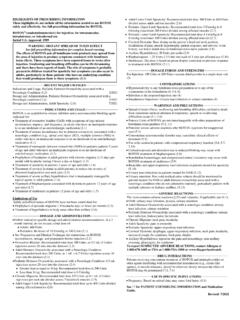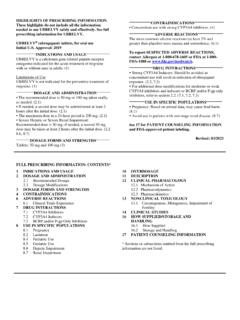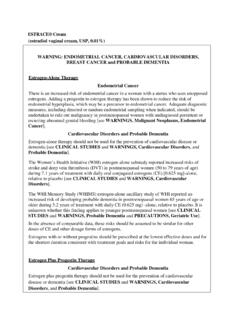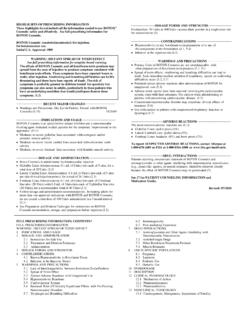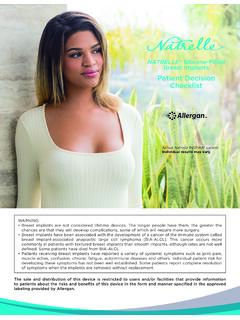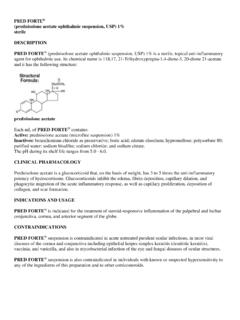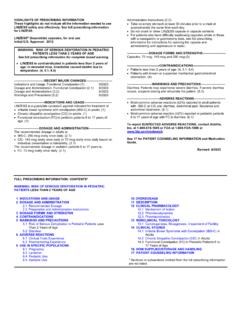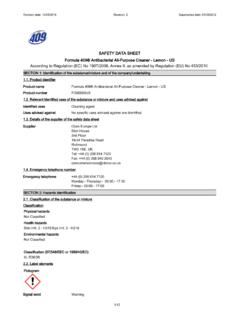Transcription of HIGHLIGHTS OF PRESCRIBING INFORMATION These ... - …
1 HIGHLIGHTS OF PRESCRIBING INFORMATION These HIGHLIGHTS do not include all the INFORMATION needed to use RESTASIS safely and effectively. See full PRESCRIBING INFORMATION for RESTASIS . RESTASIS (cyclosporine ophthalmic emulsion) For topical ophthalmic use Initial Approval: 1983 _____INDICATIONS AND USAGE_____ RESTASIS is a calcineurin inhibitor immunosuppressant indicated to increase tear production in patients whose tear production is presumed to be suppressed due to ocular inflammation associated with keratoconjunctivitis sicca. Increased tear production was not seen in patients currently taking topical anti-inflammatory drugs or using punctal plugs. (1) _____DOSAGE AND ADMINISTRATION_____ Instill one drop of RESTASIS ophthalmic emulsion twice a day in each eye approximately 12 hours apart.
2 (2) _____DOSAGE FORMS AND STRENGTHS_____ Cyclosporine ophthalmic emulsion mg/mL (3) _____CONTRAINDICATIONS_____ Hypersensitivity (4) _____WARNINGS AND PRECAUTIONS_____ To avoid the potential for eye injury and contamination, be careful not to touch the vial tip to your eye or other surfaces. ( ) _____ADVERSE REACTIONS_____ The most common adverse reaction following the use of RESTASIS was ocular burning (17%). ( ) To report SUSPECTED ADVERSE REACTIONS, contact Allergan at 1-800-433-8871 or FDA at 1-800-FDA-1088 or See 17 for PATIENT COUNSELING INFORMATION . Revised: 07/2017 FULL PRESCRIBING INFORMATION : CONTENTS* 1 INDICATIONS AND USAGE 2 DOSAGE AND ADMINISTRATION 3 DOSAGE FORMS AND STRENGTHS 4 CONTRAINDICATIONS 5 WARNINGS AND PRECAUTIONS Potential for Eye Injury and Contamination Use with Contact Lenses 6 ADVERSE REACTIONS Clinical Trials Experience Post-marketing Experience 8 USE IN SPECIFIC POPULATIONS Pregnancy Lactation Pediatric Use Geriatric Use 11 DESCRIPTION 12 CLINICAL PHARMACOLOGY Mechanism of Action Pharmacokinetics 13 NONCLINICAL TOXICOLOGY Carcinogenesis, Mutagenesis, Impairment of Fertility 14 CLINICAL STUDIES 16 HOW SUPPLIED/STORAGE AND HANDLING 17 PATIENT COUNSELING INFORMATION * Sections or subsections omitted from the full PRESCRIBING INFORMATION are not listed.
3 FULL PRESCRIBING INFORMATION 1 INDICATIONS AND USAGE RESTASIS ophthalmic emulsion is indicated to increase tear production in patients whose tear production is presumed to be suppressed due to ocular inflammation associated with keratoconjunctivitis sicca. Increased tear production was not seen in patients currently taking topical anti-inflammatory drugs or using punctal plugs. 2 DOSAGE AND ADMINISTRATION Invert the unit dose vial a few times to obtain a uniform, white, opaque emulsion before using. Instill one drop of RESTASIS ophthalmic emulsion twice a day in each eye approximately 12 hours apart. RESTASIS can be used concomitantly with lubricant eye drops, allowing a 15-minute interval between products. Discard vial immediately after use. 3 DOSAGE FORMS AND STRENGTHS Ophthalmic emulsion containing cyclosporine mg/mL 4 CONTRAINDICATIONS RESTASIS is contraindicated in patients with known or suspected hypersensitivity to any of the ingredients in the formulation.
4 5 WARNINGS AND PRECAUTIONS Potential for Eye Injury and Contamination Be careful not to touch the vial tip to your eye or other surfaces to avoid potential for eye injury and contamination. Use with Contact Lenses RESTASIS should not be administered while wearing contact lenses. Patients with decreased tear production typically should not wear contact lenses. If contact lenses are worn, they should be removed prior to the administration of the emulsion. Lenses may be reinserted 15 minutes following administration of RESTASIS ophthalmic emulsion. 6 ADVERSE REACTIONS The following serious adverse reactions are described elsewhere in the labeling: Potential for Eye Injury and Contamination [see Warnings and Precautions ( )] Clinical Trials Experience Because clinical trials are conducted under widely varying conditions, adverse reaction rates observed in the clinical trials of a drug cannot be directly compared to rates in the clinical trials of another drug and may not reflect the rates observed in practice.
5 In clinical trials, the most common adverse reaction following the use of RESTASIS was ocular burning (17%). Other reactions reported in 1% to 5% of patients included conjunctival hyperemia, discharge, epiphora, eye pain, foreign body sensation, pruritus, stinging, and visual disturbance (most often blurring). Post-marketing Experience The following adverse reactions have been identified during post approval use of RESTASIS . Because These reactions are reported voluntarily from a population of uncertain size, it is not always possible to reliably estimate their frequency or establish a causal relationship to drug exposure. Reported reactions have included: hypersensitivity (including eye swelling, urticaria, rare cases of severe angioedema, face swelling, tongue swelling, pharyngeal edema, and dyspnea); and superficial injury of the eye (from the vial tip touching the eye during administration).
6 8 USE IN SPECIFIC POPULATIONS Pregnancy Risk Summary Clinical administration of cyclosporine ophthalmic emulsion is not detected systemically following topical ocular administration [see Clinical Pharmacology ( )], and maternal use is not expected to result in fetal exposure to the drug. Oral administration of cyclosporine to pregnant rats or rabbits did not produce teratogenicity at clinically relevant doses [see Data]. Data Animal Data At maternally toxic doses (30 mg/kg/day in rats and 100 mg/kg/day in rabbits), cyclosporine oral solution (USP) was teratogenic as indicated by increased pre- and postnatal mortality, reduced fetal weight and skeletal retardations. These doses (normalized to body surface area) are 5,000 and 32,000 times greater, respectively, than the daily recommended human dose of one drop (approximately 28 mcL) of cyclosporine ophthalmic emulsion twice daily into each eye of a 60 kg person ( mg/kg/day), assuming that the entire dose is absorbed.
7 No evidence of embryofetal toxicity was observed in rats or rabbits receiving cyclosporine during organogenesis at oral doses up to 17 mg/kg/day or 30 mg/kg/day, respectively. These doses in rats and rabbits are approximately 3,000 and 10,000 times greater, respectively, than the daily recommended human dose. An oral dose of 45 mg/kg/day cyclosporine administered to rats from Day 15 of pregnancy until Day 21 postpartum produced maternal toxicity and an increase in postnatal mortality in offspring. This dose is 7,000 times greater than the daily recommended human dose. No adverse effects in dams or offspring were observed at oral doses up to 15 mg/kg/day (2,000 times greater than the daily recommended human dose). Lactation Risk Summary Cyclosporine is known to appear in human milk following systemic administration, but its presence in human milk following topical treatment has not been investigated.
8 Although blood concentrations are undetectable following topical administration of RESTASIS ophthalmic emulsion [see Clinical Pharmacology ( )], caution should be exercised when RESTASIS is administered to a nursing woman. The developmental and health benefits of breastfeeding should be considered along with the mother s clinical need for RESTASIS and any potential adverse effects on the breast-fed child from cyclosporine. Pediatric Use Safety and efficacy have not been established in pediatric patients below the age of 16. Geriatric Use No overall difference in safety or effectiveness has been observed between elderly and younger patients. 11 DESCRIPTION RESTASIS (cyclosporine ophthalmic emulsion) contains a topical calcineurin inhibitor immunosuppressant with anti-inflammatory effects.
9 Cyclosporine s chemical name is Cyclo[[(E)-(2S,3R,4R)-3-hydroxy-4-methyl -2-(methylamino)-6-octenoyl]-L-2-aminobu tyryl-N-methylglycyl-N-methyl-L-leucyl-L -valyl-N-methyl-L-leucyl-L-alanyl-D-alan yl-N-methyl-L-leucyl-N-methyl-L-leucyl-N -methyl-L-valyl] and it has the following structure: Structural Formula Formula: C62H111N11O12 Mol. Wt.: Cyclosporine is a fine white powder. RESTASIS appears as a white opaque to slightly translucent homogeneous emulsion. It has an osmolality of 230 to 320 mOsmol/kg and a pH of Each mL of RESTASIS ophthalmic emulsion contains: Active: cyclosporine Inactives: glycerin; castor oil; polysorbate 80; carbomer copolymer type A; purified water; and sodium hydroxide to adjust pH. 12 CLINICAL PHARMACOLOGY Mechanism of Action Cyclosporine is an immunosuppressive agent when administered systemically.
10 In patients whose tear production is presumed to be suppressed due to ocular inflammation associated with keratoconjunctivitis sicca, cyclosporine emulsion is thought to act as a partial immunomodulator. The exact mechanism of action is not known. Pharmacokinetics Blood cyclosporine A concentrations were measured using a specific high pressure liquid chromatography-mass spectrometry assay. Blood concentrations of cyclosporine, in all the samples collected, after topical administration of RESTASIS , twice daily, in humans for up to 12 months, were below the quantitation limit of ng/mL. There was no detectable drug accumulation in blood during 12 months of treatment with RESTASIS ophthalmic emulsion. 13 NONCLINICAL TOXICOLOGY Carcinogenesis, Mutagenesis, Impairment of Fertility Carcinogenesis Systemic carcinogenicity studies were conducted in male and female mice and rats.
